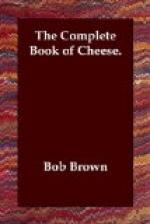BASIC WELSH RABBIT
No. 1 (with beer)
2 tablespoons butter 3 cups grated old Cheddar 1/2 teaspoon English dry mustard 1/2 teaspoon salt A dash of cayenne 1 teaspoon Worcestershire sauce 2 egg yolks, lightly beaten with 1/2 cup light beer or ale 4 slices hot buttered toast
Over boiling water melt butter and cheese together, stirring steadily with a wooden (or other tasteless) spoon in one direction only. Add seasonings and do not interrupt your rhythmic stirring, as you pour in a bit at a time of the beer-and-egg mixture until it’s all used up.
It may take many minutes
of constant stirring to achieve the
essential creamy thickness
and then some more to slick it out as
smooth as velvet.
Keep it piping hot but don’t let it bubble, for a boiled Rabbit is a spoiled Rabbit. Only unremitting stirring (and the best of cheese) will keep it from curdling, getting stringy or rubbery. Pour the Rabbit generously over crisp, freshly buttered toast and serve instantly on hot plates.
Usually crusts are cut off the bread before toasting, and some aesthetes toast one side only, spreading the toasted side with cold butter for taste contrast. Lay the toast on the hot plate, buttered side down, and pour the Rabbit over the porous untoasted side so it can soak in. (This is recommended in Lady Llanover’s recipe, which appears on page 52 of this book.)
Although the original bread for Rabbit toast was white, there is now no limit in choice among whole wheat, graham, rolls, muffins, buns, croutons and crackers, to infinity.
No. 2 (with milk)
For a rich milk Rabbit use 1/2 cup thin cream, evaporated milk, whole milk or buttermilk, instead of beer as in No. 1. Then, to keep everything bland, cut down the mustard by half or leave it out, and use paprika in place of cayenne. As in No. 1, the use of Worcestershire sauce is optional, although our feeling is that any spirited Rabbit would resent its being left out.
Either of these basic recipes can be made without eggs, and more cheaply, although the beaten egg is a guarantee against stringiness. When the egg is missing, we are sad to record that a teaspoon or so of cornstarch generally takes its place.
Rabbiteers are of two minds about fast and slow heating and stirring, so you’ll have to adjust that to your own experience and rhythm. As a rule, the heat is reduced when the cheese is almost melted, and speed of stirring slows when the eggs and last ingredients go in.
Many moderns who have found that monosodium glutamate steps up the flavor of natural cheese, put it in at the start, using one-half teaspoon for each cup of grated Cheddar. When it comes to pepper you are fancy-free. As both black and white pepper are now held in almost equal esteem, you might equip your hutch with twin hand-mills to do the grinding fresh, for this is always worth the trouble. Tabasco sauce is little used and needs a cautious hand, but some addicts can’t leave it out any more than they can swear off the Worcestershire.




